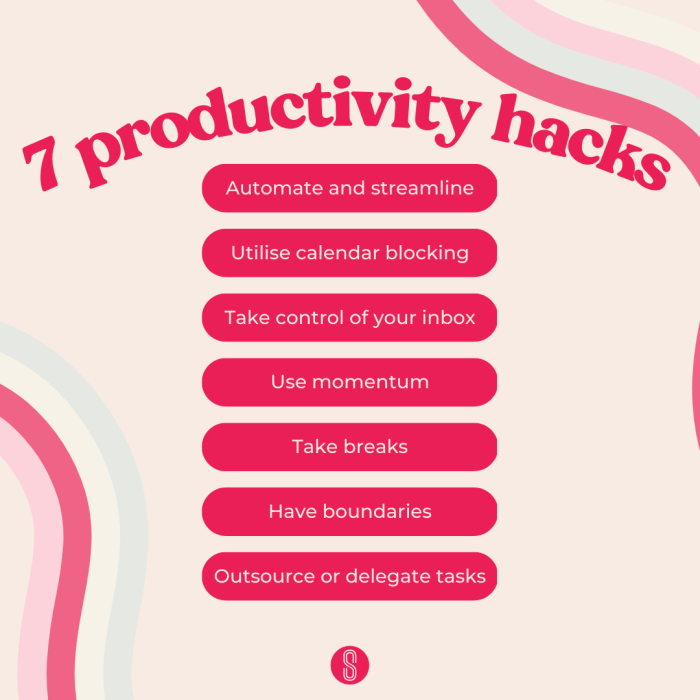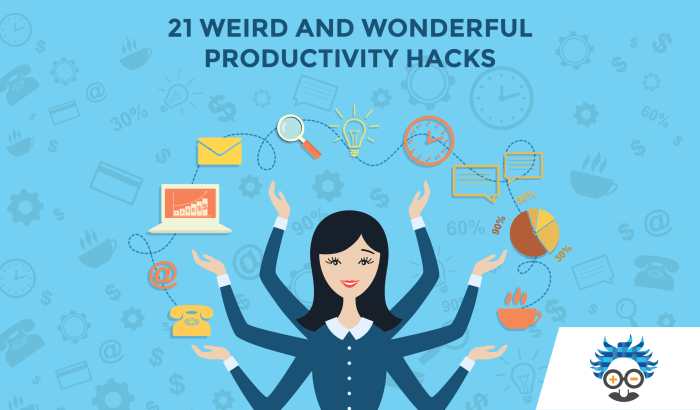Productivity Hacks sets the stage for this enthralling narrative, offering readers a glimpse into a story that is rich in detail with american high school hip style and brimming with originality from the outset.
Get ready to dive into the world of productivity hacks, where we uncover the secrets to unlocking your full potential and achieving success like never before.
Definition of Productivity Hacks

Productivity hacks are like super cool tricks and techniques that help you get stuff done faster and better. It’s all about finding clever ways to be more efficient and make the most out of your time. These hacks can be applied to various aspects of life, from work to school to daily chores, to help you be a total productivity ninja!
Examples of Popular Productivity Hacks
- Time Blocking: Dividing your day into specific blocks of time dedicated to different tasks to increase focus and productivity.
- Pomodoro Technique: Working in short bursts of intense focus followed by short breaks to maintain high productivity levels.
- Creating To-Do Lists: Writing down tasks and prioritizing them to stay organized and on track with your goals.
- Setting SMART Goals: Establishing Specific, Measurable, Achievable, Relevant, and Time-bound goals to keep yourself motivated and accountable.
Benefits of Implementing Productivity Hacks
- Increased Efficiency: By using productivity hacks, you can streamline your workflow and accomplish more in less time.
- Reduced Stress: Being organized and focused allows you to feel more in control of your tasks, leading to lower stress levels.
- Improved Work-Life Balance: Productivity hacks help you manage your time effectively, giving you more time to relax and enjoy life outside of work or school.
Time Management Techniques
Effective time management is crucial for maximizing productivity and achieving goals. By utilizing various strategies and methods, individuals can better organize their tasks and make the most of their time. Let’s explore some key time management techniques:
Time Blocking
Time blocking is a method where you divide your day into blocks of time dedicated to specific tasks or activities. By creating a schedule and allocating time for each task, you can ensure that important activities are completed efficiently. This technique helps in eliminating distractions and improving focus, leading to increased productivity throughout the day.
- Start by identifying your most important tasks for the day and allocate specific time blocks to work on them.
- Set realistic time limits for each task to prevent overcommitting and feeling overwhelmed.
- Include breaks in between time blocks to rest and recharge, enhancing overall productivity.
Remember, effective time blocking requires discipline and commitment to sticking to the schedule you’ve created.
Task Prioritization
Prioritizing tasks is essential for managing time effectively. By categorizing tasks based on their urgency and importance, you can focus on completing high-priority activities first. This approach helps in avoiding procrastination and ensures that critical tasks are addressed promptly.
- Use tools like Eisenhower’s Urgent/Important Principle to classify tasks into four categories: urgent and important, important but not urgent, urgent but not important, and neither urgent nor important.
- Focus on completing tasks in the urgent and important quadrant first, followed by important but not urgent tasks.
- Regularly review and update your task list to adapt to changing priorities and deadlines.
By incorporating time blocking and task prioritization techniques into your daily routine, you can enhance your time management skills and boost productivity levels significantly.
Technology Tools for Productivity

In today’s fast-paced world, technology plays a crucial role in enhancing productivity. By leveraging various tools and software, individuals and teams can streamline their workflow, automate repetitive tasks, and collaborate more efficiently.
Task Management Apps
Task management apps are essential tools for organizing to-do lists, setting deadlines, and tracking progress on various projects. These apps, such as Trello, Asana, or Todoist, offer features like task prioritization, due date reminders, and team collaboration options. By utilizing task management apps, individuals can stay focused, meet deadlines, and improve overall productivity.
Calendar Applications
Calendar applications, like Google Calendar or Microsoft Outlook, help users schedule appointments, set reminders, and plan their day effectively. These tools enable individuals to manage their time efficiently, avoid double bookings, and allocate time for important tasks. By using calendar applications, individuals can optimize their daily schedule and enhance productivity.
Collaboration Platforms
Collaboration platforms, such as Slack, Microsoft Teams, or Zoom, facilitate communication and teamwork among remote or distributed teams. These platforms offer features like instant messaging, video conferencing, and file sharing, enabling team members to collaborate seamlessly. By leveraging collaboration platforms, teams can improve communication, share ideas, and work together efficiently, ultimately boosting productivity.
Automation Software
Automation software, like Zapier, IFTTT, or Microsoft Power Automate, allows users to automate repetitive tasks and workflows. These tools eliminate manual data entry, streamline processes, and save time on routine activities. However, while automation software can boost productivity by reducing human error and increasing efficiency, it may also lead to dependency on technology and lack of personal touch in certain tasks.
Pros and Cons of Technology Tools for Productivity, Productivity Hacks
When it comes to using technology tools for productivity enhancement, there are both pros and cons to consider. On the positive side, these tools can help individuals and teams save time, improve efficiency, and collaborate effectively. However, over-reliance on technology tools may lead to distractions, decreased human interaction, and potential cybersecurity risks. It is essential to strike a balance between utilizing technology for productivity gains and maintaining a healthy work-life balance.
Workspace Organization Tips
Creating an optimal workspace layout can significantly impact your productivity levels. A well-organized workspace can help you stay focused, reduce distractions, and boost efficiency. Here are some tips to help you optimize your workspace:
Declutter Your Space
- Start by getting rid of any unnecessary items on your desk or in your workspace. Clutter can lead to a cluttered mind, making it harder to concentrate.
- Organize your supplies and materials in designated storage areas to keep everything within reach but out of the way.
- Consider implementing a minimalist approach to your workspace design to create a clean and calming environment.
Arrange Your Workspace Strategically
- Position your computer monitor at eye level to reduce strain on your neck and eyes.
- Create designated zones for different tasks, such as a work area, a reference area, and a storage area.
- Keep frequently used items within arm’s reach to minimize unnecessary movement and interruptions.
Personalize Your Space
- Add personal touches like photos, plants, or motivational quotes to make your workspace feel inviting and inspiring.
- Choose ergonomic furniture and accessories to promote good posture and comfort while working.
- Experiment with different lighting options to find the right balance of natural and artificial light for optimal productivity.